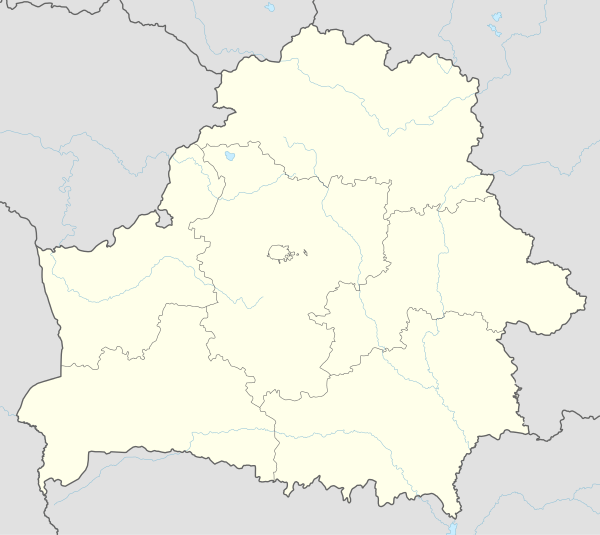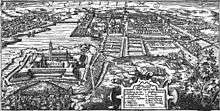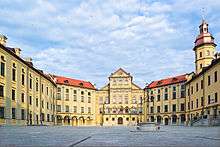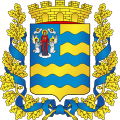Nyasvizh
Nesvizh, Niasviž (Belarusian: Нясві́ж [nʲaˈsʲvʲiʐ]; Lithuanian: Nesvyžius; Polish: Nieśwież; Russian: Не́свиж; Yiddish: ניעסוויז; Latin: Nesvisium) is a city in Belarus. It is the administrative centre of the Nyasvizh District (rajon) of Minsk Region and site of Niasviž Castle a World Heritage Site. Its 2009 population is 14,300.[1]
Nesvizh Russian: Не́свиж | |
|---|---|
City | |
 | |
 Flag  Coat of arms | |
 Nesvizh Location of Nesvizh, shown within the Minsk Region | |
| Coordinates: 53°13′N 26°40′E | |
| Country Region District | Nyasvizh District |
| First mentioned | 1223 |
| Town rights | 1586 |
| Population (2009) | |
| • Total | 14,300 people |
| Time zone | UTC+3 (FET) |
| Area code(s) | +375 1770 |
| Website | |
History
Nesvizh was first documented in 1223, becoming after the Union of Krewo (1385) part of the Grand Duchy of Lithuania and in 1569 part of the Republic of the Two Nations.[2] In the 15th century, while still a minor town, it belonged to the Kiszka family and later to the Radziwiłł family, and remained the family's seat until 1813.

In 1561 or 1562 Maciej Kawęczyński founded the print works of the Polish Brethren.[3] The first Belarusian language book printed in Latin script, a catechism by Symon Budny, was published in Nesvizh in 1562.[4] The Nieśwież Bible (Biblia nieświeska), one of the oldest Polish translations of the Bible, also by Budny, was completed there in 1571 and published in 1572.
Nesvizh Castle was erected in 1583, and between 1584 and 1598 the Benedictines and Jesuit religious orders founded monasteries and a college.[5] At the request of Mikołaj "the Orphan" Radziwiłł Nieśwież was granted Magdeburg town rights by King Stephen Báthory in 1586.[6] Two epidemics affected the city early in the 17th century which led to the establishment of a pharmacy in 1627.
During the Great Northern War of 1700–21, the city was significantly damaged by Swedish troops. It was rebuilt in the 1720s by Michał "Rybeńko" Radziwiłł. In the aftermath of the war, in 1740s and 1750s he founded a Pas slucki factory which was later moved to Sluck. He introduced a military school, several textile factories and restored the Corpus Christi Church and opened a print works. Michał's wife, Franciszka Urszula Radziwiłłowa, founded the Nieśwież Radziwiłł Theatre, including a choir and a ballet school.
_(2).jpg)
Between 1764 and 1768 the city was occupied by Russian troops, and in 1772, at the First Partition of Lithuania-Poland, the library, which comprised circa 10,000 volumes, along with paintings and other art objects, was seized and transferred to St. Petersburg. Some books from the library were passed to the Russian Academy of Sciences.
.jpg)
After the Second partition of Lithuania-Poland in 1793, Nieśwież was annexed by Russia, and renamed Nesvizh. In 1906, the Polish Society "Oświata" ("Education") in Nesvizh was established, but its activities were hampered by the Russian administration, before banning it at the start of 1910.[6] In 1912 the Russian authorities also liquidated the Roman Catholic Charity Society in Nesvizh.
After the fall of tsarist Russia, fighting broke out for control over the city and surrounding region. During the Soviet occupation (Polish–Soviet War), the unsuccessful Nieśwież uprising by Polish residents took place during March 14–19, 1919.[6] However, Nieśwież was recaptured by Poles on April 19, 1919 and re-integrated with the reestablished Polish state. It was became a powiat in the Nowogródek Voivodeship until the Soviet invasion of Poland in September 1939.[6] During World War II, from 1939 to 1941 it was under Soviet occupation, from 1941 to 1944 under German occupation, and from 1944 to 1945 under Soviet occupation again, before it was once more taken from the territory of Poland and annexed by the Soviet Union, in accordance with the Potsdam Agreement.
Hegemony
Nesvizh was part of:
- Lithuanian Grand Duchy before 1569
- Polish–Lithuanian Commonwealth between 1569-1793
- Russian Empire (except short occupation by France in 1812) between 1793-1918
- German Empire (1918)
- Belarusian People's Republic (1918-1919)
- Lithuanian–Byelorussian Soviet Socialist Republic (as part of USSR) in 1919
- Poland (1919-1939) (except short occupation by USSR in 1920)
- Byelorussian Soviet Socialist Republic (1939-1941 and 1944-1991) and
- Germany (1941-1944).
The Jews of Nesvizh
The Jewish population in 1900 stood at 4,687,and approx. 4,500 on the eve of the German invasion, Operation Barbarossa.[7] With the occupation from June 27, 1941, a Judenrat was established. On October 30, 4,000 of the town's Jews were murdered and the rest confined to a ghetto. On July 20, 1942, the ghetto was surrounded by Belorussian police and the German commander announced that the ghetto's population would be liquidated with the exception of 30 essential skilled workers. The ghetto's underground organization, based on a Soviet-era Zionist group, called an uprising armed only with one machine gun, small arms but mostly knives. Most of the Jews were killed. A few escaped to nearby forests and joined partisan units, such as the Zhukov Jewish partisan unit.[8]
Main sights
- Nesvizh Castle, the family complex of the Radziwiłł family, is a World Heritage Site.
- The Corpus Christi Church, built between 1587 and 1593, is one of the earliest Jesuit churches in the world and one of the first baroque buildings in the Polish–Lithuanian Commonwealth. It came to influence the later architecture of present-day Belarus, Poland and of Lithuania. It contains the tombs of the Radziwiłł family.
- Slutsk Gate, a city gate constructed around 1700. Its name refers to the city of Slutsk.
- Baroque Town Hall and cloth hall
- Baroque Benedictine monastery
- Baroque Craftsman House from 1721, formerly known as the Gdansk House, named after the city of Gdańsk
 Nesvizh Castle courtyard
Nesvizh Castle courtyard Slutsk Gate
Slutsk Gate Town Hall and cloth hall
Town Hall and cloth hall.jpg) Benedictine monastery
Benedictine monastery Gdańsk House
Gdańsk House
Twin towns - sister cities
Nyasvizh is twinned with:[9]
















Notable residents
- Karol Stanisław Radziwiłł, Lithuanian, Polish nobleman and politician
- Michael Goleniewski, Polish spy
- Piotr Jaroszewicz, Polish politician
- Michał Vituška, Belarusian leader of the Black Cats
References
- "Region information on the official website of the Nesvizh Regional Executive Committee (in Russian)". Retrieved 2009-10-02.
- "Region information on the official website of the Nesvizh Regional Executive Committee (in English)". Retrieved 2009-10-02.
- Józef Łukaszewicz, Dzieje kościołów wyznania helweckiego w Litwie, t. 2, Poznań 1822, p. 180-181
- "Minsk celebrates 440th anniversary of first Belarusian book printed in Cyrillic alphabet". Ministry of Foreign Affairs of the Republic of Belarus. Retrieved 2009-06-16.
- Г. П. Пашкоў, ed. (2006). "Нясвіж". Энцыклапедыя "Вялікае княства Літоўскае" (том 2). Мінск: Беларуская Энцыклапедыя. pp. 368–369.
- Maciej Rysiewicz. "Powstanie w Nieświeżu – z cyklu „Droga do niepodległości"". Kurier Ostrowski (in Polish). Retrieved 9 October 2019.
- "Jewish Gen Town Locator". Archived from the original on 2012-02-29. Retrieved 2010-07-01.
- Shalom Cholawski, Nesvizh in the Encyclopedia of the Holocaust, vol. 3, pp.1043-1044
- "Города-партнёры". nesvizh.gov.by (in Russian). Nyasvizh. Retrieved 2020-01-14.
External links
| Wikimedia Commons has media related to Nesvizh. |
- Official web page of Parish of «Corpus Christi» in Niasvizh
- Church of the Corpus Christi
- Gates of Sluck
- Nesvizh Regional Executive Committee
- Jurkau kutoczak — Юркаў куточак — Yury's Corner. Старажытнае дойлідства Нясьвіжа
- Monuments of Nesvizh
- Photos on Radzima.org
- History and sightseeing on belarustourism.by
- The murder of the Jews of Nesvizh during World War II, at Yad Vashem website.
- About the Jewish community of Nesvizh, at Yad Vashem website.
- Nyasvizh, Belarus at JewishGen
